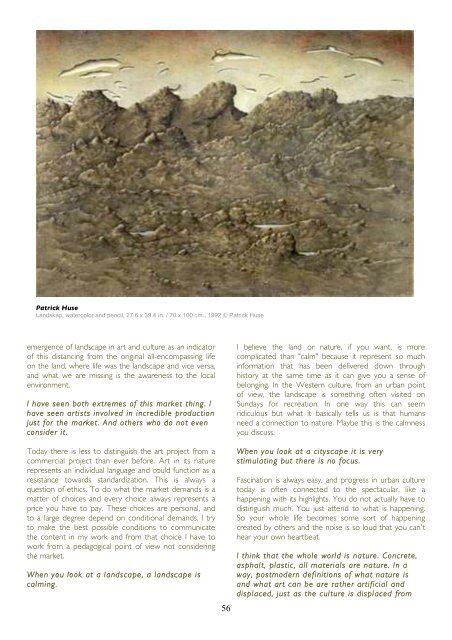M - Antennae The Journal of Nature in Visual Culture
M - Antennae The Journal of Nature in Visual Culture
M - Antennae The Journal of Nature in Visual Culture
Create successful ePaper yourself
Turn your PDF publications into a flip-book with our unique Google optimized e-Paper software.
Patrick Huse<br />
Landskap, watercolor and pencil, 27.6 x 39.4 <strong>in</strong>. / 70 x 100 cm., 1992 � Patrick Huse<br />
emergence <strong>of</strong> landscape <strong>in</strong> art and culture as an <strong>in</strong>dicator<br />
<strong>of</strong> this distanc<strong>in</strong>g from the orig<strong>in</strong>al all-encompass<strong>in</strong>g life<br />
on the land, where life was the landscape and vice versa,<br />
and what we are miss<strong>in</strong>g is the awareness to the local<br />
environment.<br />
I have seen both extremes <strong>of</strong> this market th<strong>in</strong>g. I<br />
have seen artists <strong>in</strong>volved <strong>in</strong> <strong>in</strong>credible production<br />
just for the market. And others who do not even<br />
consider it.<br />
Today there is less to dist<strong>in</strong>guish the art project from a<br />
commercial project than ever before. Art <strong>in</strong> its nature<br />
represents an <strong>in</strong>dividual language and could function as a<br />
resistance towards standardization. This is always a<br />
question <strong>of</strong> ethics. To do what the market demands is a<br />
matter <strong>of</strong> choices and every choice always represents a<br />
price you have to pay. <strong>The</strong>se choices are personal, and<br />
to a large degree depend on conditional demands. I try<br />
to make the best possible conditions to communicate<br />
the content <strong>in</strong> my work and from that choice I have to<br />
work from a pedagogical po<strong>in</strong>t <strong>of</strong> view not consider<strong>in</strong>g<br />
the market.<br />
When you look at a landscape, a landscape is<br />
calm<strong>in</strong>g.<br />
56<br />
I believe the land or nature, if you want, is more<br />
complicated than "calm" because it represent so much<br />
<strong>in</strong>formation that has been delivered down through<br />
history at the same time as it can give you a sense <strong>of</strong><br />
belong<strong>in</strong>g. In the Western culture, from an urban po<strong>in</strong>t<br />
<strong>of</strong> view, the landscape is someth<strong>in</strong>g <strong>of</strong>ten visited on<br />
Sundays for recreation. In one way this can seem<br />
ridiculous but what it basically tells us is that humans<br />
need a connection to nature. Maybe this is the calmness<br />
you discuss.<br />
When you look at a cityscape it is very<br />
stimulat<strong>in</strong>g but there is no focus.<br />
Fasc<strong>in</strong>ation is always easy, and progress <strong>in</strong> urban culture<br />
today is <strong>of</strong>ten connected to the spectacular, like a<br />
happen<strong>in</strong>g with its highlights. You do not actually have to<br />
dist<strong>in</strong>guish much. You just attend to what is happen<strong>in</strong>g.<br />
So your whole life becomes some sort <strong>of</strong> happen<strong>in</strong>g<br />
created by others and the noise is so loud that you can't<br />
hear your own heartbeat.<br />
I th<strong>in</strong>k that the whole world is nature. Concrete,<br />
asphalt, plastic, all materials are nature. In a<br />
way, postmodern def<strong>in</strong>itions <strong>of</strong> what nature is<br />
and what art can be are rather artificial and<br />
displaced, just as the culture is displaced from












